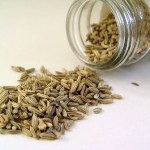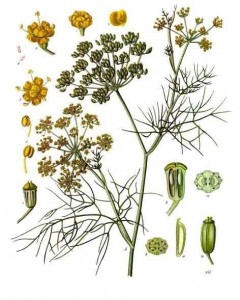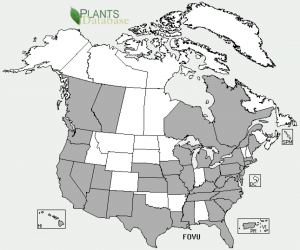Foeniculum vulgare
Native range: Mediterranean, from Turkey west to Spain and Morocco
Invasive range: Much of North and South America, South Africa, and parts of Oceania and the British Isles. Check out the USDA Plants Database to see if it’s found near you.
Habitat: Roadsides, pastures, along the edge of wild habitats. Rocky shores and hills.
Description: An erect perennial herb, four to nine feet tall, with feathery leaves and a strong anise scent. Small yellow flowers, clustered in large umbrella-like groups (compound umbels) four inches across, are conspicuous from April through July. During growing season, plants include both living and dead hollow stems, or canes. Seeds of wild fennel, oblong and ribbed, should look like those in the spice jar at home—the wild plant is the source of the seed used to flavor food. The most dangerous plant you might confuse fennel with is poison hemlock, which tends to grow near water or in moist soil, is tall (about three to six feet), has purple blotches on the main stem, and is heavily branched with small umbels of white flowers. To distinguish between it and fennel, crush some leaves and smell them––but not with your bare hands: poison hemlock contains coniine, a toxin that can be absorbed through the skin. Poison hemlock smells mousy or musty.
Fennel, also known as anise, sweet fennel, and aniseed, is native to the shores of the Mediterranean, where it has been used for centuries as a spice and an herbal medicine. In the footsteps of man and his animals, it has spread around the world and is now widely naturalized along roadsides and in pastures and other open sites, especially on dry soils near coasts and on riverbanks. In Australia and the United States, it is considered an invasive species and a weed. Although details of its introduction are unknown, on the East Coast, it likely arrived with the first European settlers. On the West Coast it has been in California for at least 120 years, where it is presumed to have escaped from cultivation repeatedly.
Fennel seems designed to invade. It reproduces from seed and root crown, developing dense, uniform stands up to seven feet tall. It is particularly aggressive in areas that are plowed or grazed and then abandoned, or what field guides call “disturbed areas,” those sites where many invaders can all too often be found, busy outcompeting the natives for light, nutrients, and water, and perhaps exuding allelopathic substances that inhibit the growth of other plants. Fennel seeds are dispersed by wind and water; birds and rodents; and mud on vehicles, shoes, and clothing. Livestock in pastures where fennel is producing seed will spread it to new sites. Most of the heavily infested areas of Santa Cruz Island, California, were formerly cattle pastures. Because of fennel’s prolific seed production from May to November and its seed viability of several years, long-lived seedbanks can build up rapidly. Its thick taproot makes eradication difficult.
Fennel through the Ages
10th century
Anglo-Saxon Nine Herbs Charm
Chervil and fennel, fearsome pair,
These herbs were wrought by the wise lord,
holy in heaven, there did he hang;
He set and sent them in seven worlds
To remedy all, the rich and the needy.
NB: Too bad they became invasive.
1847
William Darlington
Agricultural Botany: an Enumeration and Description of Useful Plants and Weeds Which Merit the Notice, or Require the Attention, of American Agriculturists
Common Foeniculum. Vulgò—Fennel. Garden Fennel. Fr. Fenouil. Germ. Der Fenchel. Span. Hinojo.
Observation. The whole plant is highly aromatic. Those who kept Bees, in former years, were much in the practice, when those insects swarmed, of rubbing the inside of the Bee-hive with this fragrant herb,—under the impression that the odor would attach them to their new domicil. It is chiefly cultivated for its aromatic fruit,—which is occasionally used in domestic economy; and is sometimes smoked, like tobacco, as a popular remedy for cholic.
1943
Merrit Lyndon Fernald & Alfred Charles Kinsey
Edible Wild Plants of North America
Fennel, originally cultivated in this country, is abundantly naturalized in waste lands, on roadsides, etc., in the Southern States, and more locally northward to southern New England, New York, Michigan, etc. It is not greatly appreciated with us but with peoples of southern European stocks is a favorite seasoning. Thus, John Parkinson, in Theatrum Botanicum (London, 1640) wrote: “the Italians especially doe much delight in the use thereof, and therefore . . . transplant it and whiten it, to make it more tender to please the taste, which being sweete and somewhat hot and comforting the stomacke, helpeth to digest the crude flegmaticke qualitie of Fish, and other viscous meats which they much inure themselves unto.”
John Evelyn, in his Acetaria (London, 1706), stated that it: “recreates the Brain; especially the tender Umbrella, and young Seeds annex’d to them. The Stalks, white, plump, and soft, are to be peel’d, and then dressed like Sellery. The early tender Tufts of the emerging Leaves, being mine’d, are eaten alone with Vinegar, or Oyl and Pepper, and to correct the cooler Materials, enter properly in Composition [of Sallets].” When one contemplates the vast wastes of Fennel about some of our more southern cities and recollects that it “recreates the Brain,” it seems a pity that it is not more often used.
Harvest
The fennel plant is used in many culinary traditions. The small flowers of wild fennel (mistakenly known in the US as “pollen”) are the most potent part, and the most expensive. When you buy dried fennel seed, you’re buying wild seed. Use the seed while it’s still green, before it dries out completely and turns a dull gray. The fronds are delicately flavored. The stems can be cooked until tender. Wild fennel has a woody taproot instead of the big edible white bulb that domestic fennel has.
To collect fennel pollen, carefully cut the flowers, leaving about six inches of stem on each. Group them into bunches of ten or so and place flower side down into a clean paper bag. Tie the top of the bag and store in a cool dry place for a few weeks. Then, shake the bag vigorously to dislodge the tiny flowers, discard the stems, and store your pollen in a small container. You can find more information at Gardenista and also read the adventures of Penni Wisner collecting fennel pollen. The pollen is delicious as a flavoring in a wide variety of dishes: on roast meats, salads, popcorn, eggs, pizza, even in coffee.
Recipes
 Fennel seed is a common ingredient in Italian sausage and meatballs and in northern European rye breads. In Spain, the stems are used in pickling eggplant. In Syria and Lebanon, fennel is combined with eggs, onions, and flour to make an omelet called ijjeh. In some parts of India, cooked fennel leaves are served as a side dish, either by themselves or mixed with other vegetables. In many parts of India and Pakistan, the roasted seeds are chewed as mukhwas, aftermeal digestives and breath fresheners.
Fennel seed is a common ingredient in Italian sausage and meatballs and in northern European rye breads. In Spain, the stems are used in pickling eggplant. In Syria and Lebanon, fennel is combined with eggs, onions, and flour to make an omelet called ijjeh. In some parts of India, cooked fennel leaves are served as a side dish, either by themselves or mixed with other vegetables. In many parts of India and Pakistan, the roasted seeds are chewed as mukhwas, aftermeal digestives and breath fresheners.
Killer Fennel/Fennel Killer Molasses Cookies
Submitted by Tony Summers of the Catalina Island Conservancy, California
Ingredients
3/4 cup margarine, melted
1 1/2 cup sugar
1 egg
1/2 cup molasses
2 cups all-purpose flour
2 tsp baking soda
1/2 tsp salt
2 tsp ground cinnamon
2 cups chopped fennel stems
1/2 tsp ground cloves
Makes approximately 5 dozen cookies.
Collect and candy fennel
Tender fennel stems and green immature seeds can be candied and used with this recipe. Tender fennel stems can be collected from plants when they are in the “bolting” phase, as long as stems snap easily when bent. Stems should be peeled and chopped finely. Stems have a much milder anise, or licorice, flavor than seeds. Add approx 1/2 cup sugar to 2 cups chopped fennel stems in a sauce pan and add just enough water to cover mixture. Simmer sugar and water until the majority of the liquid has evaporated and mixture is thick enough to not drip from a spoon. If using fennel seeds, add the same ratio of sugar to seeds but use 1/4 as much of the candied fennel in the final cookie recipe.
Prepare cookie dough
In a medium bowl, mix together the melted margarine, 1 cup sugar, and egg until smooth. Stir in the molasses. Combine the flour, baking soda, salt, cinnamon, and cloves; blend into the molasses mixture and candied fennel. Cover and chill dough for 1 hour.
Preheat oven to 375 degrees. Spread dough on smooth, floured surface and roll fairly thin with rolling pin.
Cookies should be approximately 3 inches in diameter.
Bake for 8 to 10 minutes. Candied fennel burns easily so be sure to check cookies around six to eight minutes and remove if crisp.
Angelo Garro’s Wild Fennel Cakes
Adapted from NPR’s Hidden Kitchens
Ingredients
1 1/2 lbs of wild fennel fronds
3 eggs
1 cup high-quality parmesan cheese
1 cup coarse bread crumbs (made from day-old bread ground up in a food processor or blender)
1 teaspoon crushed red pepper
Salt and black pepper to taste
Extra virgin olive oil
Peanut oil
Makes approximately 20 to 30 patties
Gather young fennel fronds—about 1 1/2 pounds. Fennel hearts are the bright green, furry piece that is in the center of the stalk of fennel. When you’re gathering them, pick only the fronds and lay them in a paper bag horizontally—all the tops should be pointing in the same direction. Keep them horizontal as you wash them gently in a bucket of water, holding them in your hands to avoid bruising.
Wash and parboil for 15 to 20 minutes. Make sure to wash fronds very well. Lay the stalks on the cutting board and chop finely. Taste to make sure they are tender. Drain and dry—you can stir a little with a wooden spoon to help the cooling process. When the fronds are cold, place in a bowl.
Mix all the dry ingredients together. Form into patties. Heat cast iron or nonsticking frying pan with a very little bit of olive oil cut with a very small amount of peanut oil. Fry fennel cakes on both sides until golden brown. Sprinkle with salt and pepper. Drain again on a paper towel. Best when served warm.
Wild Fennel Ice Cream
From Shannon Swindle, Pastry Chef, Craft Restaurant, Los Angeles. Adapted from KCRW’s Good Food, April 2012.
Ingredients
1 quart organic heavy cream
1 quart organic whole milk
8 ounces wild fennel fronds and small stems, chopped
20 organic egg yolks
1 2/3 cups granulated sugar
1 tsp fine sea salt
Place the cream, milk and wild fennel in a heavy-bottomed sauce pan, and scald over medium heat. Turn off the heat, cover the pan, and allow the mixture to steep for 1 hour. Prepare an ice bath by mixing ice and enough water to cover in a container large enough to hold a separate container of ice cream base. In a large bowl, whisk the egg yolks, sugar, and salt until well combined. Reheat the dairy and fennel mixture, and bring to a rolling boil. Pour the hot cream into the egg yolk mixture all at once. Whisk until combined and immediately pour the custard into a metal container and place in the ice bath. Stir occasionally until the base is cold.
Cover the ice cream base and refrigerate overnight. Before freezing, strain the base through a fine-mesh strainer, and freeze in an ice cream freezer according to the manufacturer’s directions.
Note: Shannon does not slowly temper the yolks and place the ice cream base back on the heat and cook until thickened as a lot of pastry chefs do. The sugar keeps the egg yolks from scrambling, and the boiling cream raises the temperature of the yolks to cook them sufficiently.
Fennel Pollen
“If you live in on the West Coast, you can gather fennel pollen yourself,” says forager Hank Shaw, “The easiest way is to gather lots of fennel flower clusters and put them in a paper bag, tying the bag closed and the stalks together. You then hang this somewhere and as the flowers dry, the pollen drops into the bag.
“The plus side of this method is that you don’t have too much work to do. The down side is that you get dried pollen, which is wonderful stuff–but not nearly as wonderful as fresh pollen.
“You collect fresh fennel pollen by going to each flower head and shaking it into a bag, dislodging the pollen, which will be a lovely, creamy yellow.”
Strawberry-and-Wild-Fennel Compote with Pound Cake
Adapted from Food & Wine, April 2011
Pastry chef Bill Corbett of Absinthe Brasserie & Bar in San Francisco harvests his own fennel pollen for this dessert by hanging wild fennel flowers upside down; as they dry, the pollen falls into a container below.
Ingredients
POUND CAKE
2 sticks unsalted butter, softened, plus more for the pan
All-purpose flour
1/2 teaspoon salt
1/2 vanilla bean, split and seeds scraped
Finely grated zest of 2 oranges
4 large egg yolks
3 large eggs
1 1/4 cups sugar
COMPOTE
2 small, young wild fennel bulbs, halved, cored and diced
1/2 vanilla bean—split, seeds scraped and bean reserved
Salt
1 pound small strawberries, diced
1/4 cup plus 2 tablespoons sugar
2 tablespoons fresh lemon juice
Wild fennel pollen, for sprinkling
Preheat the oven to 350°. Butter and flour a 9-by-4 1/2-by-3-inch metal loaf pan. In the bowl of a standing electric mixer fitted with the paddle, beat the butter with 1 3/4 cups of flour and the salt, vanilla seeds and orange zest until creamy. Scrape the mixture into a bowl. Add the egg yolks, whole eggs and sugar to the mixer bowl and beat at medium-high speed with the whisk attachment until pale and thick, about 4 minutes. Stir half of the whipped eggs into the flour paste, then fold in the rest.
Scrape the batter into the loaf pan and bake in the center of the oven for 1 1/2 hours, until the cake is risen and a skewer inserted in the center comes out clean. Let the pound cake cool in the pan for 30 minutes, then turn out onto a wire rack to cool completely.
In a 9-by-13-inch nonreactive baking dish, combine the fennel, vanilla bean, a pinch of salt and 2 tablespoons of water. Cover with foil and roast until the fennel is tender, 30 minutes. Meanwhile, in a medium bowl, toss the strawberries with the sugar, lemon juice, vanilla seeds and a pinch of salt and let stand until juicy, 30 minutes.
Add the strawberries and their juices to the fennel, cover and roast for 30 minutes. Discard the vanilla bean and transfer the compote to a bowl. Slice the cake and set a slice on each plate. Top with the compote, sprinkle with fennel pollen and serve.
* * *
Ways to use fennel pollen as a flavor from Chowhound.
Fennel pollen recipes from Fennel Friday.
Links
Pasta with Wild Fennel and Sausage. Recipe looks delicious, though I disagree with Rosetta Costatino—please do remove the entire plant, since the goal is to reduce fennel’s presence.
Wild Fennel-infused Vodka. Uses the wild fennel flowers.






























{ 2 comments… read them below or add one }
I notice that only the seeds and flowers are noted for their edibility.
Every spring the plant grows back with small fennel bulbs – it’s a bit of a chore to harvest these bulbs, but they are very good fried in olive oil and a little salt – much like the domestic fennel bulbs. Well worth the work.
In midsummer the juicy tops of the stalks are a taste treat when wandering the wilds, as are the fresh seeds.
I am trying to find a location where I can purchase wild fennel flowers.
I live in Tampa Fl
{ 2 trackbacks }